Review: Google Nexus 6P
Nov 10, 2015, 5:30 PM by Eric M. Zeman
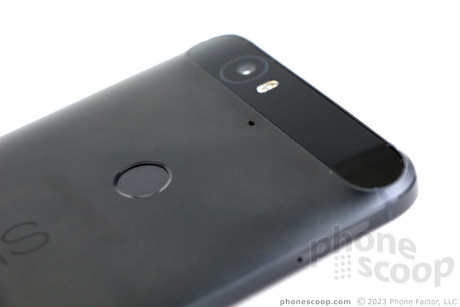
Google's flagship Android smartphone for the year is the Nexus 6P, made by Huawei. This slim and attractive handset features a metal design, quad HD display, fingerprint sensor, and Android 6.0 Marshmallow. Here is Phone Scoop's in-depth report.
Is It Your type?
This year is unique in that Google pushed out not one, but two new Nexus smartphones. Nexus-branded handsets are for a targeted set of people: those who want a "pure" Android experience and the promise of first access to new versions of Android from Google. The Nexus 6P — a successor to the 2014 Nexus 6 — is a flagship handset that ships with Android 6.0 Marshmallow. If you want to latest from Google in an attractive and well-made handset, the 6P is for you.
Body
The 6P is made by Huawei, while the 5X is made by LG. Where the 5X is small and plastic, the 6P is large and metal.
Huawei made use of decent materials to forge the 6P which — like the 5X — has simple lines defining its shape. The 6P is nearly identical in terms of size and shape to the iPhone 6s Plus. In fact, more than one person thought I was using an iPhone and not an Android handset when they spied the 6P in my hand. The front surface is as plain as can be. The rear surface is unique thanks to the enlarged top end of the phone, which is where the camera and flash are located. There is nothing earth-shattering about the 6P's design, but Nexus phones have never been about flashy designs. As if to underscore that fact, the 6P is available in three shades: frost, graphite, and aluminum; not bright, colorful hues.
The 6P is perhaps the best handset from Huawei that I've put my hands on. It is the most refined Nexus phone to-date, thanks to the metal rear panel, chamfered edges, and slim profile. It doesn't have quite the same quality as the iPhone or HTC One A9, but it's really close. I have no complaints about the quality whatsoever.
Like the iPhone 6s Plus, the Nexus 6P's large footprint makes it impractical for some users. It may be slim, but the width may be too much for those with smaller hands to grasp. It's worth noting that the 6P is significantly smaller than the Nexus 6, which had a bigger screen. That's good news. Thanks to the metal skin, the 6P is a weighty handset. It's well balanced, and slips into pockets quit easily. Still, the footprint means the 6P's presence is always felt.
Huawei gave the 6P a 5.7-inch screen. It takes up a fair amount of the phone's front face, but there are still healthy bezels above and below the display. Unlike the 5X, the 6P does have stereo speakers, which are plainly visible slits in the glass. There are no buttons, and the user-facing camera is more or less invisible. I like the uncluttered look.
The side and back are formed from one piece of metal. I really appreciate the attention to detail in the fine treatment of the edges and chamfers, which give the phone a significant dash of class.
The only two buttons are positioned on the right of the phone. The screen lock button is the smaller of the two and placed on top. The buttons have good profiles and are easy to find/use. Travel and feedback is significantly better than the same buttons on the 5X. I like that the screen lock button has a ribbed texture to help it stand apart. The SIM card tray is located on the left side of the phone. You'll find the headphone jack and USB Type-C charging port on the bottom.
A few words about Type-C. This connector is reversible, which makes it much easier to use; no more futzing about trying to figure out which way to insert the darned thing. It is fast, can send power in both directions, and represents the future of phone charging/data transfer. For now, however, accessories are limited. In fact, the phone comes with one Type-C cable and a wall wart that works only with the included Type-C cable. In other words, if you lose either the cable or charger, you're screwed. You may want to buy extra cables and/or adapters online.
The 6P's rear panel is not removable; the battery is sealed in. That may be a dealbreaker for some. Like the bulk of Nexus devices, the 6P doesn't support expandable memory.
The 6P has a fingerprint sensor and it's positioned on the back surface. I didn't have any trouble locating the sensor nor placing my index finger on it. I found it comfortable to use. The camera module is hidden behind a raised glass surface at the top of the rear panel. The dual LED flash is visible, but the camera lens itself is hard to spot in the black glass.
I like the Nexus 6P's design, materials, and build quality much more than those of the Nexus 5X. The improved experience will cost you $120 more, though, which puts it in a different price category.
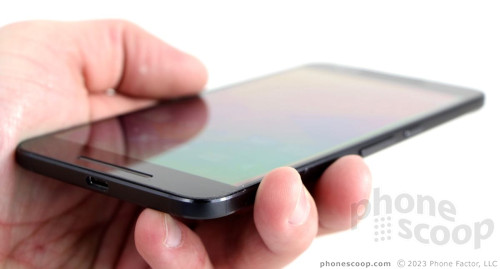
Screen
The 6P's display measures 5.7 inches across the diagonal and offers quad HD (2560 x 1440) resolution. The screen looks fantastic. Quad HD displays will spoil your eyes. The resolution is incredibly sharp and the AMOLED pixels of the 6P are bright. Colors are a bit intense (at the expense of accuracy), but viewing angles are excellent. I had no trouble using the 6P outdoors under a sunny sky. It's a great screen.
Signal
The Nexus 6P is sold unlocked with support for a wide range of networks. I tested it on AT&T's network in and around New York City and came away pleased with the results. The 6P never lost its connection to AT&T's network, though it dropped from LTE to HSPA+ on several occasions. I was able to connect the majority of calls on the first dial. The 6P did not miss nor drop calls while I tested it, and it was able to keep calls connected when traveling down the highway. Data speeds were just a bit quicker than those I saw from the 5X. When used to surf the net, scan through Twitter, and upload images to Instagram, the 6P played on even footing when compared to other AT&T handsets.
Sound
The 6P is a solid voice phone. Volume through the earpiece is more than adequate to make calls audible at home, the office, and even busy coffee shops or diners. Clarity is also quite good; I had no trouble understanding callers in a variety of locations. Voices don't necessarily sound warm and fuzzy, but I didn't experience any distortion or other oddness.
The speakerphone dials volume back a bit, but quality is still solid. I found the speakerphone loud enough for home and the office, but it was hard to hear in the car or a restaurant. Voices were nice and clear, and even with the volume all the way up, the speakerphone didn't exhibit any distortion.
Ringers and other alerts were always able to grab my attention. The vibrate alert was always able to make me aware of incoming calls and text messages.
Battery
The 6P delivers battery life far superior to the 5X. Huawei bestowed it with a 3,450 mAh lithium-polymer battery, and it easily lasts through an entire day. I consistently had 25% or more battery capacity left at bedtime over a week's worth of heavy testing. I tested the 6P with LTE, Bluetooth, GPS, WiFi, and NFC radios on, with the screen set at 50% brightness. It covered my butt no matter how much I used it.
The 6P supports rapid charging technology, as well. According to Google, the 6P can ingest about 7 hours of uptime after about 10 minutes when plugged into a charger. Of course, with the USB Type-C plug, making sure you always have a charger available isn't as easy as with older phones. But I don't think you'll need to use the basic battery saver tool.
Bluetooth, GPS, NFC, WiFi
All of the 6P's radios performed as expected. The phone supports a fairly wide set of Bluetooth profiles, and I had no trouble pairing with PCs, speakers, headphones, and my car. Call quality through my car's hands-free system was quite good. Clarity was nice and volume was sufficient enough for highway speeds. Music sounded quite punchy through my favorite Bluetooth speaker. The 6P's Bluetooth outperformed the 5X's by a significant margin.
Google Maps ran perfectly on the 6P, and the GPS radio was able to peg me in Maps quickly and accurately. It located me within 5 seconds, and was accurate to about 25 feet.
The NFC radio worked great for helping pair the 6P with Bluetooth devices, and also did its job when taking advantage of Tap & Go during initial setup.
The WiFi worked very well.
Comments
No messages


















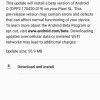 Google Pushes Minor Update to Android O Beta
Google Pushes Minor Update to Android O Beta
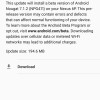 Google Pushes Second Beta of Android 7.1.2
Google Pushes Second Beta of Android 7.1.2
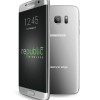 Republic Wireless Improves Android Lineup
Republic Wireless Improves Android Lineup
 Google Releases Final Developer Preview of Android 7 Nougat
Google Releases Final Developer Preview of Android 7 Nougat
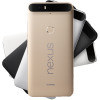 Google Reveals When Nexus Phones Will Cease Receiving Android Updates
Google Reveals When Nexus Phones Will Cease Receiving Android Updates
 Huawei Nexus 6P
Huawei Nexus 6P




